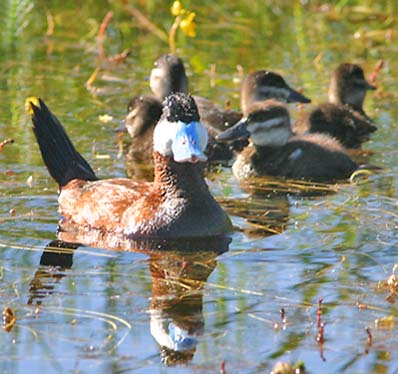
a web page by Don Roberson |
DUCKS, GEESE & SWANS Anatidae |
||||||
|
||||||
 |
||||||
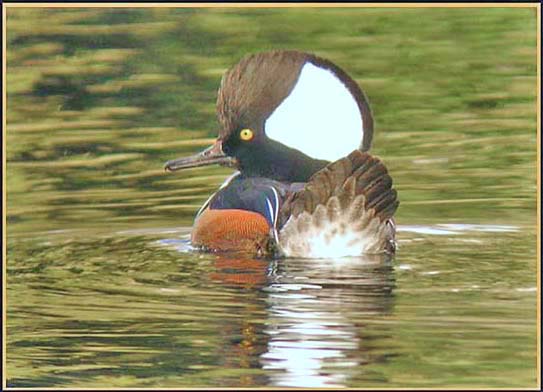 The
Anatidae — a huge family that includes ducks, geese, and swans — are
strongly associated with water habitats around the world. The family
has great diversity in size, shape, color, and behavior. Black Swan (above; adult with young) frequents open lakes in Australia. Hooded Merganser (male, left) prefers quiet, wooded ponds in North America; it rather rarely raises its impressive crest. Huge flocks of Snow Goose and Ross's Goose
migrate from the northern tundra to winter together in places like
California's Central Valley. The noise of flock like this taking off
(below) can be deafening. Many of these refuges were created by hunting
interests, but now attract birders to enjoy the spectacle. The
Anatidae — a huge family that includes ducks, geese, and swans — are
strongly associated with water habitats around the world. The family
has great diversity in size, shape, color, and behavior. Black Swan (above; adult with young) frequents open lakes in Australia. Hooded Merganser (male, left) prefers quiet, wooded ponds in North America; it rather rarely raises its impressive crest. Huge flocks of Snow Goose and Ross's Goose
migrate from the northern tundra to winter together in places like
California's Central Valley. The noise of flock like this taking off
(below) can be deafening. Many of these refuges were created by hunting
interests, but now attract birders to enjoy the spectacle. |
||||||
 |
||||||
 |
||||||
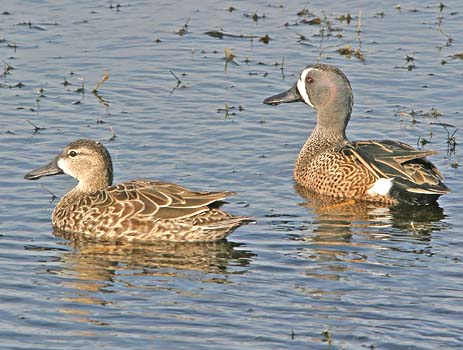 Ducks have a wide variety of strategies for survival. Some species are mostly sedentary, like African Pygmy-Goose of the African tropics (above). Others are comparatively short distance migrants, such as Blue-winged Teal
within interior North America (right). Yet others are spectacular
long-distance migrants. Smew, a small merganser that breeds in the high
Palearctic, is an example. Species with long migratory routes will spin
off vagrants to delight the birding world. This male Smew
(below) appeared briefly in mid-winter in the foothills of California's
Sierra Nevada range for two winters running. In my shot the Smew was
just crossing a patch of water with impressive reflections of the far
shore. Ducks have a wide variety of strategies for survival. Some species are mostly sedentary, like African Pygmy-Goose of the African tropics (above). Others are comparatively short distance migrants, such as Blue-winged Teal
within interior North America (right). Yet others are spectacular
long-distance migrants. Smew, a small merganser that breeds in the high
Palearctic, is an example. Species with long migratory routes will spin
off vagrants to delight the birding world. This male Smew
(below) appeared briefly in mid-winter in the foothills of California's
Sierra Nevada range for two winters running. In my shot the Smew was
just crossing a patch of water with impressive reflections of the far
shore. |
||||||
 |
||||||
| Waterfowl as a family is a noncontroversial concept, but there has been a lot of debate about the arrangement of the subfamilies and tribes within the family, and about the relationship of the Anatidae to other families. The Handbook of the Birds of the World (Carboneras 1992) sets up 3 subfamilies and 12 tribes, but one of those subfamilies is Magpie-Goose, which many recent authorities (e.g., Dickinson 2003) and I treat as a separate family [Anserantidae]. | ||||||
|
||||||
 |
||||||
Here in North America we tend to divide our standard freshwater species into the 'puddle ducks,' such as Northern Shoveler (above) and the 'diving ducks,' like Ring-necked Duck (below). These two groups forage in different ways, which makes 'puddle ducks' common in shallow, weedy ponds with 'diving ducks' typically restricted to deep-water venues. The Wood Duck (right) is neither; it is a distinctive species on its own, breeding in old woodpecker holes in dead trees in riparian areas, or in nest-boxes now put up widely for its protection. |
||||||
 |
||||||
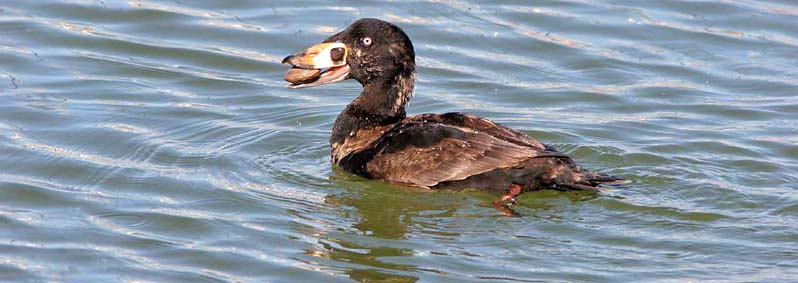 |
||||||
Harlequin Duck (male & female, left) migrate substantial distances between breeding and wintering grounds. Some nest along rushing mountain streams, but they winter on salt water. Long-tailed Duck (imm. male, below) breeds even farther north in the Arctic tundra and may have the longest migration route of any duck. |
||||||
 |
||||||
The other cascade specialists are Blue Duck Hymenolaimus malacorhynchus of New Zealand and Salvadori's Teal Salvadorina waigiuensis of New Guinea. I've had the good fortune to watch both working the rapids of roaring rivers in the mountains of those islands. |
||||||
|
||||||
Vagrant waterfowl present a variety of problems. First, one must evaluate whether the bird is a wild vagrant or an escape for captivity; this Trumpeter Swan in Texas (right) presented exactly that problem. Second, identification of vagrants requires caution. Issues in identifying white swans in North America have caused many problems; see Banko (1980), Bailey (1991), and Patten & Heindel (1994). Other local California problems have been addressed by such papers as Wallace & Ogilvie (1985), Tobish (1986), Jackson (1992, 1993), or Martin & DiLabio (1994). All these papers are much better resources that 'standard' family tomes (e.g., Palmer 1976 or Madge & Burn 1988) for identifying vagrants. Finally, issues of hybridization are legion. Gillham et al. (1966) & Gillham (1987) cover some of the many problems. There are a set of waterfowl, usually placed right at the end of the family chronology, called stifftails. Ruddy Duck (male with a brood behind; below left) can be brilliant in summer and does impressive chin-bobbing displays in courtship. This species cruises out into open water and is easy to view. In contrast, Masked Duck of the Neotropics (below right) is a skulker, hiding in the reeds, and can be difficult to locate (Lockwood 1997). This particular one, though, was a vagrant to Florida at a locale where hiding spots were limited. |
||||||
|
||||||
Photos: The Black Swan Cygnus atratus with brood was on Lake Ballarat, Victoria, Australia, in Nov 1983. The male Hooded Merganser Lophodytes cucullatus was in Carmel Valley, California, on 7 Dec 2004. The flock of Snow Goose Chen caerulescens & Ross's Goose C. rossii was at Merced NWR, California, in 26 Dec 1999. The African Pygmy-Goose Nettapus auritus was on Lake Bisini, Uganda, on 30 July 2004. The pair of Blue-winged Teal Anas discors were at Vierra, Florida, on 21 Dec 2006. The vagrant male Smew Mergellus albellus was in Tuolumne Co., California, 28 Jan 2007. The Spotted Whistling-Ducks Dendrocygna guttata were at Port Moresby, Papua New Guinea, on 14 Oct 1983. The "Black" Brant Branta bernicla nigricans was at Monterey, California, on 17 Feb 2007. The Spur-winged Goose Plectropterus gambensis was at Lake Jipe, Kenya, on 26 Nov 1981. The female Common Merganser Mergus merganser with brood was on the Big Sur River, California, on 7 June 2008. The flock of Northern Shoveler Anas clypeata was at the south end, Salton Sea, California, on 14 Apr 2006. The male Wood Duck Aix sponsa was at Santee Lakes, near San Diego, California, on 10 Apr 2008. The male Ring-necked Duck Aythya collaris was in Tuolumne Co., California, on 27 Jan 2007. The imm. male Surf Scoter Melanitta perspicillata and Long-tailed Duck Clangula hyemalis were at Moss Landing, California, on 5 Mar 2008. The pair of Harlequin Duck Histrionicus histrionicus were in the Monterey harbor, California, in Jan 2007. The Torrent Duck Merganetta armata was seen from the train down the Urubamba River to Machupicchu, Peru, in July 1987. The pair of Steller's Eider Polysticta stelleri were at Gambell, St. Lawrence I., Alaska, on 4 June 1980; the vagrant imm. male was at Crescent City, California, on 9 Feb 2003. Greg W. Lasley photographed the adult Trumpeter Swan Cygnus buccinator, which may or may not be a wild vagrant, at Kerr Co., Texas, in Feb 1999. The male Ruddy Duck Oxyura jamaicensis was in Sierra Valley, California, on 22 June 2006. The female Masked Duck Oxyura dominica was at Vierra, Florida, on 21 Dec 2006. All photos © D. Roberson, except the Trumpeter Swan © Greg W. Lasley, and used with permission; all rights reserved. Bibliographic essay: Family Book:
Family Book:
Literature cited:
|
||||||

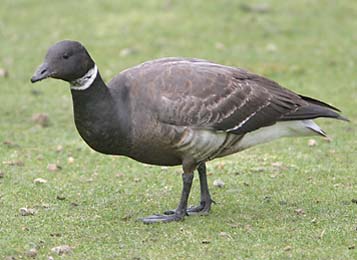


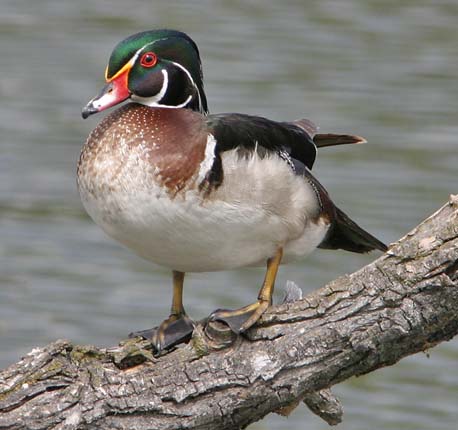 In
many ducks there is strong sexual dimorphism, with males sporting
conspicuous and classic patterns most of the year (except for a brief
"eclipse" plumage during wing-molt) and females often dressed in
camouflage patterns. In many species males are promiscuous and do not
share any of the duties of raising young. "Rape" is a common behavior
in many of the "puddle ducks" (like Mallard Anas platyrhychos).
In
many ducks there is strong sexual dimorphism, with males sporting
conspicuous and classic patterns most of the year (except for a brief
"eclipse" plumage during wing-molt) and females often dressed in
camouflage patterns. In many species males are promiscuous and do not
share any of the duties of raising young. "Rape" is a common behavior
in many of the "puddle ducks" (like Mallard Anas platyrhychos). 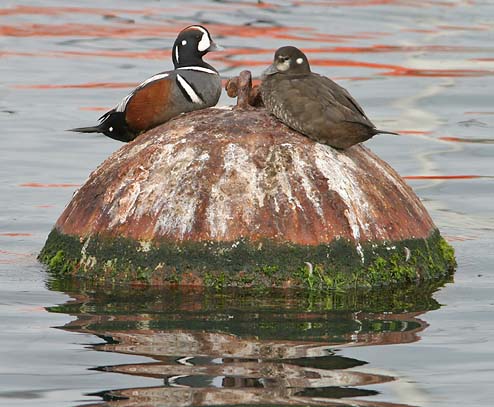 To
this point the photos have been mostly of freshwater ducks, but there
is an impressive selection of salt-water species. The scoters,
represented by Surf Scoter (above), are primarily mullusk-eaters. This young male has a large clam.
To
this point the photos have been mostly of freshwater ducks, but there
is an impressive selection of salt-water species. The scoters,
represented by Surf Scoter (above), are primarily mullusk-eaters. This young male has a large clam. Some
of all the most impressive waterfowl are the cascade specialists —
those ducks that spent their lives in and by rushing streams in the
Andes or Australasian mountains. Incredible swimmers with elongated
bodies and long maneuverable tails, somehow they are at home in the
swiftest of currents. I've been fortunate to observe all of them in
habitat. The Torrent Duck (left) is silhouetted
against the turbulent Urubamba River in the Peruvian Andes; a close-up
of the same shot (inset left) proves it to be a white-headed male.
Some
of all the most impressive waterfowl are the cascade specialists —
those ducks that spent their lives in and by rushing streams in the
Andes or Australasian mountains. Incredible swimmers with elongated
bodies and long maneuverable tails, somehow they are at home in the
swiftest of currents. I've been fortunate to observe all of them in
habitat. The Torrent Duck (left) is silhouetted
against the turbulent Urubamba River in the Peruvian Andes; a close-up
of the same shot (inset left) proves it to be a white-headed male.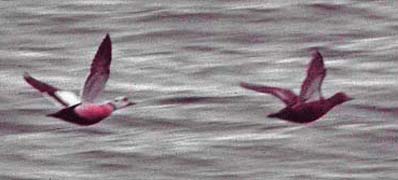

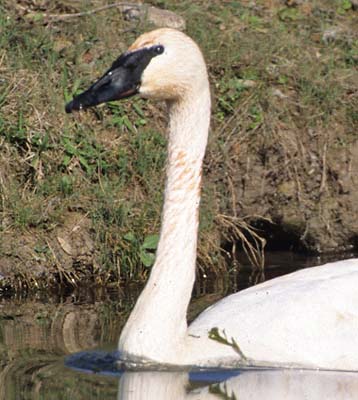 Because
many species of waterfowl are long distance migrants, there is the
possibility for vagrants. Usually one must go to the far north to see Steller's Eider,
for example. This pair (above left) were flying past St. Lawrence
Island in the Bering Sea. That is a very special duck, but it is even
more dramatic when one appears far south, just as this imm. male (above
right) that appeared in the Crescent City harbor between Jan-May 1983
(this photo taken in pouring rain).
Because
many species of waterfowl are long distance migrants, there is the
possibility for vagrants. Usually one must go to the far north to see Steller's Eider,
for example. This pair (above left) were flying past St. Lawrence
Island in the Bering Sea. That is a very special duck, but it is even
more dramatic when one appears far south, just as this imm. male (above
right) that appeared in the Crescent City harbor between Jan-May 1983
(this photo taken in pouring rain). 